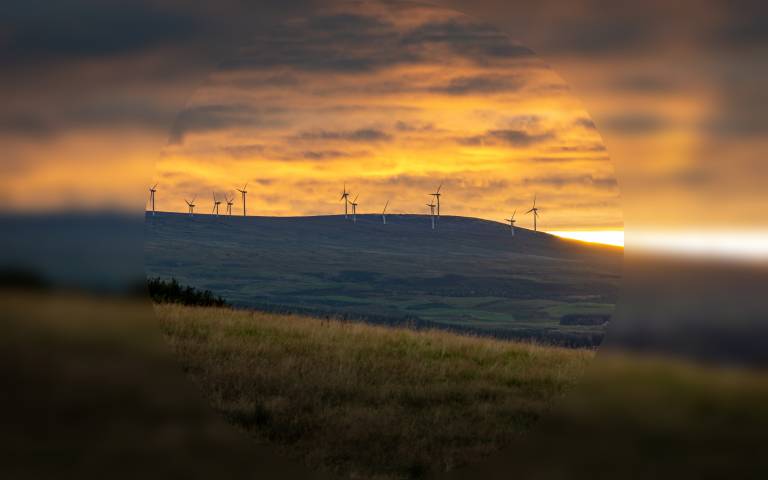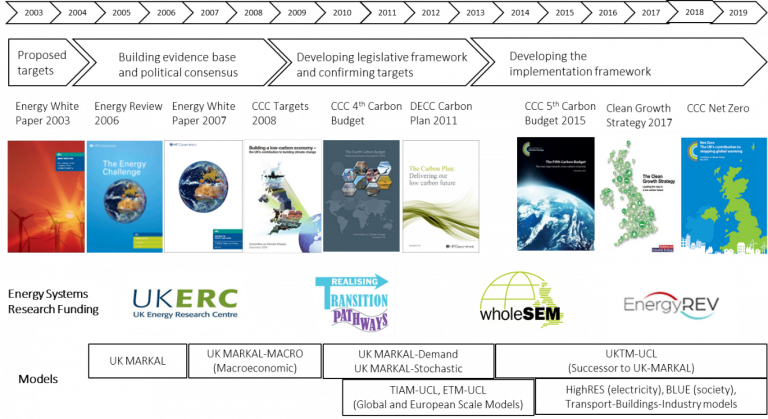UK decarbonisation pathways
20 April 2021

At a glance
- The UK was the first major economy to legislate a decarbonisation pathway to net zero greenhouse gas emissions by 2050
- Energy system research (especially energy modelling), played a key role in understanding how this target could be met
- The UK has met its interim milestones (through 2020), but is currently significantly off-track to meet its longer-term target
- Meeting this target is a huge challenge and requires sustained and comprehensive action, including:
- International coordination with all other countries;
- Well-designed and consistent government policies;
- Firms making very large investments in new energy technologies and infrastructures in every sector; and
- The engagement and involvement of all UK citizens.
Why and how do we set UK decarbonisation pathways?
Deep reductions of carbon dioxide (CO2) and other greenhouse gas emissions are required to prevent damaging impacts from climate change. This requires an energy transition from a high-carbon to a low- or zero-carbon energy system.
Figure 1 shows the progress in the UK over the last 20 years to set decarbonisation targets. Energy research, anchored via major projects with UK universities (e.g. the UK Energy Research Centre, UKERC), helped understand the range of systems issues and trade-offs. Specifically, energy system models (first MARKAL, then TIMES) produced pathways to frame the discussion, with further modelling to investigate key complexities in these pathways. The UK and devolved governments then engaged with all stakeholders through a series of policy publications.

Figure 1: Recent timeline of UK decarbonisation policy process and supporting research

This led in 2008 to the UK being the first major economy to legislate an 80% reduction in emissions by 2050, from 1990 levels. Critically, an independent body (the Climate Change Committee, CCC) was established to set interim milestones (every 5 years) on the road to 2050, and to monitor how the UK government is doing in meeting these milestones. In 2019, in light of growing scientific evidence on the need to decarbonise faster, the UK’s long-term target was strengthened to net zero (where residual emissions are balanced by removal of CO2 from the atmosphere) by 2050. Such a policy architecture is designed to give certainty to investors, companies, and citizens that the energy transition will happen.
What is the UK’s decarbonisation pathway and are we meeting it?
Figure 2 shows the UK’s emissions milestones (5-year carbon budgets) on its pathway to net zero by 2050. The UK has met its first three carbon budgets (2010, 2015, 2020). However, the UK is currently projected to struggle to meet its 4th and 5th carbon budgets (the 5th budget in 2030 is -57% from 1990 levels).
This shortfall in the necessary policies to enable the energy transition [2] became even greater when on 3rd December 2020, the Prime Minister announced the UK would commit to a tougher target of -68% by 2030. This level of ambition is the UK’s contribution to the negotiations at the next major global conference (COP26) where all countries are expected to increase their current levels of decarbonisation ambition. As the host country of COP26 (held in Glasgow in November 2021), the UK is in the spotlight to retain its global leadership on this issue.
A few days after the Prime Minister’s announcement on the 2030 target, the CCC published its advice for the 6th carbon budget (for 2035) suggesting a -78% reduction target (or 200 MtCO2/year). The UK is significantly off-track to meet this milestone on the pathway to net-zero emissions.
![Figure 2: UK target setting and emissions milestones [1]](https://www.ucl.ac.uk/bartlett/sites/bartlett/files/styles/large_image/public/figure_2_0.png?itok=qEs9iUDc)
Figure 2: UK target setting and emissions milestones [1]
![Figure 2: UK target setting and emissions milestones [1]](https://www.ucl.ac.uk/bartlett/sites/bartlett/files/styles/large_image/public/figure_2_0.png?itok=qEs9iUDc)
What is the solution?
The key insight from energy modelling is that we need a systems solution to the UK decarbonisation pathway to net-zero emissions. This requires an integrated approach:
- a rapid installation of new technologies to turn sustainable resources (e.g. wind, solar, biomass) into low-carbon fuels (electricity, hydrogen and biofuels);
- new or adapted infrastructures to get these fuels to where they are needed (in industry, buildings and transport); and
- a set of consistent policies
- to get energy prices right,
- to be super-efficient in energy demand,
- to be innovative in the development of new technologies,
- to have a flexible energy system that balances energy supply-demand;
- to ensure consumers have clear information on energy choices.
What is stopping the solution being implemented?
Decarbonisation is an unprecedented challenge. Its scope ranges across every facet of our economy and how we live our lives. It has lots of different decision makers (politicians, regulators, company CEOs, civil society leaders, local organisations etc.) all needing to make major decisions now that will have consequences for decades to come. As a result, there are numerous trade-offs and uncertainties in different possible pathways.
Our energy models tell us decarbonisation will impose significant (yet manageable) costs on society, perhaps 1-2% of GDP by 2050. Of course, if we do not act then significant climate impacts will cost us a great deal more. But how do we ensure that these costs are paid equitably across society, especially as they are likely to fall unequally on different groups and areas in the country? And how do we also meet our other energy goals, namely having a secure supply, ensuring the most vulnerable people can access energy services (e.g., in heating their homes), and having the best outcomes for other environmental and health impacts?
Figure 3 shows how the UK is doing in its decarbonisation efforts. Our most impressive progress has been in the power system as our electricity generation has switched from coal, and more recently gas, to a huge up-take in renewables (notably offshore wind and solar). This has been partly achieved by good policies to support new technologies and ensure there is enough capacity to keep the lights on. But the UK has also benefitted from global investments that have driven down the costs of renewables by a factor of 5 or even 10 in just a decade.
However, Figure 3 also shows how much less decarbonisation progress has been made in the buildings and transport sectors. This is due to strongly embedded existing technologies (e.g., gas boilers in homes and internal combustion engine cars), the need to develop new infrastructures to provide alternative fuels, that buildings and private transport are very important to people’s lifestyles leading to a reluctance to change to something very novel, and the political difficulties in trying to maintain coalitions for change.
![Figure 3: UK progress in reducing emissions [2]](https://www.ucl.ac.uk/bartlett/sites/bartlett/files/styles/large_image/public/figure_3_0.png?itok=NGqyxaDH)
Figure 3: UK progress in reducing emissions [2]
![Figure 3: UK progress in reducing emissions [2]](https://www.ucl.ac.uk/bartlett/sites/bartlett/files/styles/large_image/public/figure_3_0.png?itok=NGqyxaDH)
How can these barriers be removed?
First, we need continued energy systems research. This includes state-of-the-art modelling to probe the trade-offs and complexities in energy systems pathways (across geography, through time, between consumer income groups, amongst incumbent vs. new entrant firms, and from developed to emerging economies). But it also requires empirical studies (i.e. what has worked and not worked), as well as participatory approaches (with both experts and citizens) to really understand the motivations of all energy stakeholders.
Second, the UK needs to lead – and hence benefit – from global decarbonisation efforts to innovate and drive-down the costs of new technologies. For example, if vehicle battery packs can continue their rapid reduction in costs and improvement in range, electric cars could be no more expensive than petrol cars by 2025.
Third, there are key uncertainties for UK decarbonisation pathways (that are the subject of future publications in this series). These include:
- The design and consistency of government policy – carbon pricing, energy efficiency, enabling of new technologies and infrastructures, and information provision;
- The strategies of both existing and new firms in the energy sector as they make very large investments in green technologies in the electricity, buildings, and transport sectors; and
- The social practices of people as both voters for new policies, and consumers of new technologies and services.
Conclusion
Can the UK build on its leading position on decarbonisation pathways as we recover from the global Covid-19 pandemic and set our sights on net-zero emissions by 2050? It is a huge and complex challenge. To meet it we need an integrated systems approach that includes well-designed and consistent government policies, fair investment conditions for innovative energy technologies and services, and the involvement of all UK citizens.
Key references for further information
Analysis of the UK’s decarbonisation pathway to net zero emissions by 2050:
- CCC (2019). Net Zero. The UK's contribution to stopping global warming, Committee on Climate Change. London www.theccc.org.uk/publication/net-zero-the-uks-contribution-to-stopping-global-warming/
Assessment on how the UK is currently doing in meeting this target:
- CCC (2020). Reducing UK emissions: Progress report to Parliament, Committee on Climate Change. London. www.theccc.org.uk/publication/reducing-uk-emissions-2020-progress-report-to-parliament
Comparison of decarbonisation pathways for 16 major countries (including the UK):
- Waisman, H., et al (2019). A pathway design framework for national low greenhouse gas emission development strategies. Nature Climate Change 9(4): 261-268.
 Close
Close


